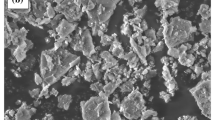Abstract
There are still concerns in the scientific community about the stability of nanostructured YSZ coatings at high temperatures. Questions have been raised about the possibility of accelerated sintering of these ultrafine materials and the associated changes in properties that could accompany this sintering. In this work, nanostructured YSZ coatings were engineered to counteract sintering effects by tailoring the coatings to exhibit a bimodal microstructure formed by (i) a matrix of dense YSZ zones (produced from molten YSZ particles) and (ii) large porous nanostructured YSZ zones (produced from semimolten nanostructured YSZ particles) that were embedded in the coating microstructure during thermal spraying. These coatings were subjected to heat treatment in air at 1400 °C for 1, 5, and 20 h. The superior driving force for sintering exhibited by the porous nanozones, when compared to that of the dense zones, caused the nanozones to shrink at much faster rates than those exhibited by the denser matrix zones (i.e., differential sintering), thereby creating a significant network of voids in the coating microstructure. Due to these effects, after 20 h exposure at 1400 °C, the thermal conductivity and elastic modulus values of the conventional coatings were approximately two times higher than those of the nanostructured ones.










Similar content being viewed by others
References
R.S. Lima, A. Kucuk, C.C. Berndt (2002) Bimodal Distribution of Mechanical Properties on Plasma Sprayed Nanostructured Partially Stabilized Zirconia. Mater. Sci. Eng. A 327:224-232
R.S. Lima, B.R. Marple (2007) Thermal Spray Coatings Engineered from Nanostructured Ceramic Agglomerated Powders for Structural, Thermal Barrier and Biomedical Applications: A Review. J. Therm. Spray Technol. 16(1):40-63
B. Liang, C. Ding (2005) Thermal Shock Resistances of Nanostructured and Conventional Zirconia Coatings Deposited by Atmospheric Plasma Spraying. Surf. Coat. Technol. 197:185-192
W.Q. Wang, C.K. Sha, D.Q. Sun, X.Y. Gu (2006) Microstructural Feature, Thermal Shock Resistance and Isothermal Oxidation Resistance of Nanostructured Zirconia Coating. Mater. Sci. Eng. A 424:1-5
R.S. Lima, B.R. Marple (2008) Nanostructured YSZ Thermal Barrier Coatings Engineered to Counteract Sintering Effects. Mater. Sci. Eng. A 485:182-193
G. Antou, F. Hlawka, A. Cornet, C. Becker, D. Ruch, A. Richie (2006) In Situ Laser Remelted Thermal Barrier Coatings: Thermophysical Properties. Surf. Coat. Technol. 200:6062-6072
K. Muraleedharan, J. Subrahmanyam, S.B. Bhaduri (1988) Indentification of t’ Phase in ZrO2-7.5wt%Y2O3 Thermal-Barrier Coatings, J. Am. Ceram. Soc. 71(5):p C-226-227
D. Zhu, R.A. Miller (2000) Thermal Conductivity and Elastic Modulus Evolution of Thermal Barrier Coatings under High Heat Flux Conditions. J. Therm. Spray Technol. 9(2):175-180
O. Racek, C.C. Berndt, D.N. Guru, J. Heberlein (2006) Nanostructured and Conventional YSZ Coatings Deposited Using APS and TTPR Techniques. Surf. Coat. Technol. 201:338-346
A. Kulkarni, Z. Wang, T. Nakamura, S. Sampath, A. Goland, H. Herman, J. Allen, J. Ilavsky, G. Long, J. Frahm, R.W. Steinbrech (2003) Comprehensive Microstructural Characterization and Predictive Property Modeling of Plasma-Sprayed Zirconia Coatings. Acta Mater. 51:2457-2475
A. Kulkarni, A. Vaidya, A. Goland, S. Sampath, H. Herman (2003) Processing Effects on Porosity-Property Correlations in Plasma Sprayed Yttria-Stabilized Zirconia Coatings. Mater. Sci. Eng. A 359:100-111
Author information
Authors and Affiliations
Corresponding author
Additional information
This article is an invited paper selected from presentations at the 2008 International Thermal Spray Conference and has been expanded from the original presentation. It is simultaneously published in Thermal Spray Crossing Borders, Proceedings of the 2008 International Thermal Spray Conference, Maastricht, The Netherlands, June 2-4, 2008, Basil R. Marple, Margaret M. Hyland, Yuk-Chiu Lau, Chang-Jiu Li, Rogerio S. Lima, and Ghislain Montavon, Ed., ASM International, Materials Park, OH, 2008.
Rights and permissions
About this article
Cite this article
Lima, R.S., Marple, B.R. Toward Highly Sintering-Resistant Nanostructured ZrO2-7wt.%Y2O3 Coatings for TBC Applications by Employing Differential Sintering. J Therm Spray Tech 17, 846–852 (2008). https://doi.org/10.1007/s11666-008-9217-x
Received:
Revised:
Accepted:
Published:
Issue Date:
DOI: https://doi.org/10.1007/s11666-008-9217-x




